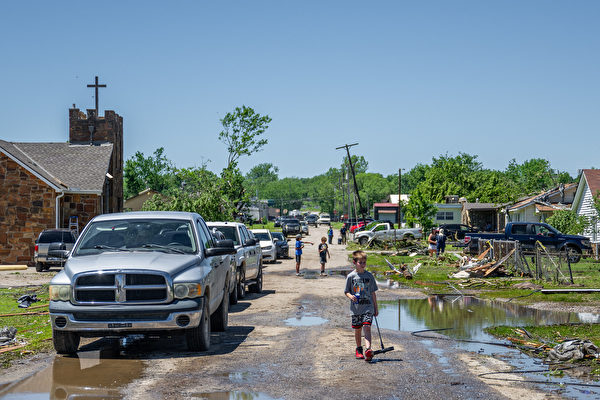Several tornadoes, large hail, destructive gusts, and heavy rains struck the Great Lakes region and Ohio River Valley on Tuesday, followed by another round of storms in the eastern and central United States on Wednesday. Over 145 million people across states from Texas to Maine are expected to face storm onslaughts.
April to June marks the peak season for tornadoes in the United States, with May historically having the highest tornado activity. The Storm Prediction Center reports that there have been tornado warnings every day since April 25, totaling 287 tornado reports during this period.
On Wednesday, nearly 4 million people will face a level 4 (out of 5) severe thunderstorm risk, including parts of Missouri, Illinois, Kentucky, and Tennessee, with Nashville falling within this range.
Moreover, approximately 50 million people, from Texas through the Ohio River Valley to the mid-Atlantic, are at risk of level 2 to 3 severe thunderstorms.
Early morning storms began in eastern Kansas with their scope and intensity expected to expand through the morning, advancing towards parts of Missouri, impacting the entire day ahead.
If powerful organized storm lines form in the morning, severe winds will pose the greatest threat in the afternoon, potentially accompanied by hail and tornadoes. The risk of significant tornadoes (at least EF2 intensity, corresponding to wind speeds of 109-134 mph) will increase if the organized tornado line fails to develop.
Regions in Missouri, Illinois, Indiana, Kentucky, and Tennessee face the highest risk of severe tornado formation, especially starting in the afternoon.
Throughout the afternoon, more storms are anticipated from the southern plains to the mid-Atlantic. Texas, Kentucky, and Tennessee are most likely to experience the strongest storms and largest hail, with any storm posing a threat of destructive winds and hail the size of softballs.
Certain areas may encounter an initial round of severe storms early Wednesday, followed by another round later in the day.
Wednesday’s multiple storm rounds will also bring heavy rainfall, heightening flood risks.
The National Weather Service states, “The greatest flash flood threat also overlaps with the severe thunderstorm risk, primarily in parts of Kentucky, Tennessee, and adjacent states.” According to the Weather Prediction Center, the flash flood risk in these areas is at level 3 of 4.
Rainfall rates could reach 2 inches per hour, significantly increasing the potential for flash flooding. Areas repeatedly hit by storms might record over 4 to 5 inches of rainfall.
Severe tornadoes and storms swept through southwest Michigan late Tuesday, causing property and business destruction, with dozens of residents sustaining minor injuries and being hospitalized.
Tornadoes are unusual in Michigan, but the city of Union in Branch County faced an unprecedented situation. The city was included in Michigan’s first tornado emergency, warned by the National Weather Service as a “large, destructive tornado” located approximately 10 miles northwest of Coldwater, moving northeast at 45 mph.
According to the Storm Prediction Center, Michigan experienced at least 10 tornadoes on Tuesday, with reports of softball-sized hail in some areas.
As reported by poweroutage.us, by early Wednesday, over 30,000 households and businesses in Michigan were without power.
Governor Gretchen Whitmer expressed sympathy for those affected by severe weather in southwest Michigan, stating, “We will be working through the night with the emergency team to monitor the situation and coordinate resources for affected residents.” She declared Kalamazoo, St. Joseph, Branch, and Cass counties in a state of emergency late Tuesday.

